Tue 17 Mar 2020
A 1001 Midnights Review by Bill Pronzini: RAYMOND CHANDLER – The Lady in the Lake.
Posted by Steve under 1001 Midnights , Pulp Fiction , Reviews[6] Comments
by Bill Pronzini
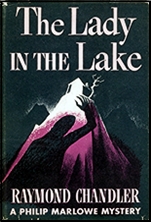
RAYMOND CHANDLER – The Lady in the Lake. Alfred A. Knopf, hardcover, 1943. Pocket #389, paperback; 1st printing, September 1946. Film: MGM, 1946, as Lady in the Lake (with Robert Montgomery as Philip Marlowe).
Even though The Lady in the Lake is not Chandler’s best novel. it is this reviewer’s favorite. It too was “cannibalized” from three pulp novelettes: “Bay City Blues·” (Dime Detective, November 1937), “The Lady in the Lake” (Dime Detective, January 1939), “No Crime in the Mountains” (Detective Story, September 1941), but it is not as seamless as The Big Sleep or Farewell, My Lovely, nor as wholly credible. Nevertheless. there is an intangible quality about it, a kind of terrible and perfect inevitability that combines with such tangibles as Chandler’s usual fascinating assortment of characters and some unforgettable moments to make it extra satisfying.
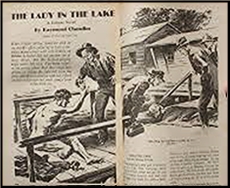
The novel opens with Marlowe hired by Derace Kjngsley, a foppish perfume company executive, to find his missing wife. Crystal (who he admits he hates and who may or may not have run off with one of his “friends,” Chris Lavery). Marlowe follows a tortuous and deadly trail that leads him from L.A. to the beach community of Bay City, to Little Fawn Lake high in the San Bernardino Mountains, to the towns of Puma Point and San Bernardino, and back to to L.A. and Bay City. And it involves him with a doctor named Almore, a tough cop named Degarmo, a half-crippled mountain caretaker, Bill Chess, whose wife is also missing, Kingsley’s secretary, Miss Adrienne Fromsett and the lady in the lake, among other victims.
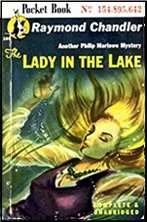
As the dust jacket or the original edition puts it, it is “a most extraordinary case, because … Marlowe understands that what is important is not a clue – not the neatly stacked dishes, not the strange telegram … but rather the character of [Crystal Kingsley]. When he began to find out what she was like, he took his initial steps into a world of evil, and only then did the idea of what she might have done and what might have been done to her take shape. So it was that not one crime but several were revealed, and a whole series of doors that hid cruel things were suddenly opened.
“Again Chandler proves that he is one of the most brilliant craftsmen in the field, and that his Marlowe is one of the great detectives in fiction.”
Amen.
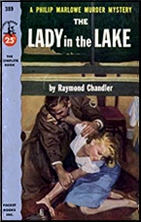
The Lady in the Lake was filmed in 1946. with Robert Montgomery (who also directed) as Marlowe. For its time, it was a radical experiment in film-making, in that it is entirely photographed as if through the eyes of Marlowe — a sort of cinematic version of the first-person narrator, with Montgomery himself never seen except in an occasional mirror reflection. The technique doesn’t quite work – it, not the story, becomes the focus of attention – but the film is an oddity worth seeing.
———
Reprinted with permission from 1001 Midnights, edited by Bill Pronzini & Marcia Muller and published by The Battered Silicon Dispatch Box, 2007. Copyright © 1986, 2007 by the Pronzini-Muller Family Trust.
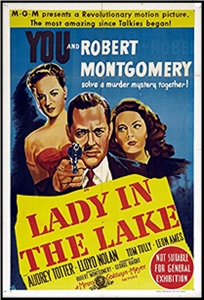
March 17th, 2020 at 8:28 pm
This and THE HIGH WINDOW are probably the least appreciated of the Marlowe novels (aside from PLAYBACK), though I have always found them to be superior work, only lesser in comparison to his very best books.
Compared to anyone but Chandler himself they are both outstanding.
I’ve always thought the last line of this one was Chandler at his best.
The film for all its oddity works on its own terms with a solid performance from Lloyd Nolan who ironically subbed for Marlowe when THE HIGH WINDOW was filmed as TIME TO KILL in the Michael Shayne series.
March 17th, 2020 at 10:34 pm
Loved the book, wholeheartedly disliked the movie. Except for Lloyd Nolan, of course, and yes, Audrey Totter, too. But then again, I can easily watch Audrey Totter in anything.
March 18th, 2020 at 5:40 am
Dark Passage, starring Bogart and Bacall, based on a novel by David Goodis – now there’s come-on signs for you! – uses the first-person camera technique for about a third of the film, so it has time to startle, but it doesn’t get tedious. I’ve seen documentaries (by Chris MArker?) that use the same device.
March 18th, 2020 at 8:28 am
Quite right, Roger. I have mixed feelings about DARK PASSAGE and its use of the first person camera, but even so, I think it’s a very much underrated film.
March 18th, 2020 at 8:30 am
This was the first thing by Chandler that I ever read, and more than 50 years later I still remember the last line, so I agree with David Vineyard about that. I liked the book a lot and went on to read the other Marlowe novels fairly quickly. I was thinking about rereading this one and THE HIGH WINDOW, since I don’t really remember much about their plots.
March 18th, 2020 at 9:09 am
My personal favorite Chandler is THE HIGH WINDOW, but LADY is right up there, for all the reasons Bill mentioned.
As for the film, it grows very tiresome very quickly. Montgomery’s direction distracts the viewer from his bad acting, but it’s a matter of covering one smell with another.